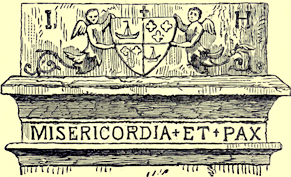Chapter XIX: Dissolution of the Monastery, 1547-1571
He was charged with the murder of King Henry, with conspiring against the King, with lying in wait in the woods of Callandar for the slaughter of Lord Lennox, and with participating in the murder of the Regent Murray. He denied all the charges. The evidence against him was somewhat strange, and not very convincing, but it was deemed sufficient. The master of the school of Paisley, a Sir Thomas Robeson, gave evidence that a follower of the Archbishop's had made auricular confession to him of the murder of the King at Kirk of Field. The name of this follower was John Hamilton, commonly called Black John. He and eight vassals of the Archbishop had received from him the keys of the house where the King slept: they strangled their victim, and drew him into the garden. The deed weighed heavily on the mind of Black John. “He was troubled in his soul by day and night, his conscience tormenting him. Endeavouring to find ease, he remembered a schoolmaster in Paisley, a Papist, who comforted him, reminding him of the mercy of God. Soon after he died.”[33] This schoolmaster was now brought from Paisley to Stirling to tell his story against his former Abbot. The Archbishop answered nothing to his tale, but, eyeing him, said, “You are not ignorant of the punishment due to those who reveal the secrets of Confession?”[34] The prisoner was condemned to death, and on the scaffold is said to have confessed that he knew of the Regent's murder and might have stopped it, for which he asked God's mercy.[35] “As touching his religion,” says the writer we have followed, “I reasoned with him, and could find naething bot he was ane Papist, and exhorted such as were near him on the scaffold to abide in the Catholic faith (so he termed the Papistrie), and in the castel he desired some Papist priest to whom he might confess him, and of whom he might receive consolation (absolution?) of his sins according to the order of the Kirk (so he spak), and so he continued to the death in his Papistrie as he lived. As the bell struck at six hours at even he was hangit at the mercat cross of Stirling upon the jebat.[36]
So died the last Archbishop of the old Church of Scotland, and the last Abbot of Paisley. He was a man of great ability, and, if he had faults, he was not worse than most men of his station and of his time. Upon the gallows his enemies affixed the lines:—
Cresco diu fella arbor, semper que vireto,
Frondibus ut nobis talia poma feras.[37]
But there were some in Stirling who sorrowed at his fate, and at the dead of night these other lines were nailed to the door of the church of the town.
Infelix pereas arbor, si forte virebis,
Imprimis utinam carminis authoreas.
After his execution, his body was quartered,[38] but those friends who had so curiously expressed their regret, probably carried his mangled remains to Paisley. There is in the church a tablet, which looks as it had marked his grave. It has upon it the Archbishop's coat of arms, the letters J. H., the initials of his name, and the motto he assumed, and which contrasts strangely with his troubled life and tragic end
—
“Misericordia, et Pax.”[39]

[33] Buchanan, p. 266.
34] Buchanan. He says that fifteen months afterwards this schoolmaster suffered for saying mass, and that he still adhered at his death to the evidence he had given at Stirling.
[35] Diurnal of Oocurrents.
[36] Gallows. Ibid. I can find no authority for the statement that he was hanged over the Bridge of Stirling in full canonicals.
[37] Grow long happy tree, and ever let thy leaves be green,
That thou mayest bear such fruit for us.
The wretched latinity of the second verse has been thus skilfully translated by a friend:—
Perish thou wretched gallows tree,
Or if perchance thou flourish should,
That rhymster vile, I pray to good,
May quickly find his way to thee.
[38] Tytler, Vol. II., p. 337.
[39] This tablet was taken at the last restoration of the church from the outside of the west gable, where it had been carelessly built in, and placed for safety in its present position at the west end of the north aisle.—See Chap. XX.